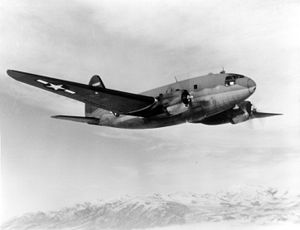Curtiss-Wright C-46 Commando
| C-46 Commando | |
|---|---|
 |
|
| A wartime photograph of a US Army Air Force (USAAF) C-46 Commando | |
| Role | Military transport aircraft |
| National origin | United States |
| Manufacturer | Curtiss-Wright Corporation |
| First flight | 26 March 1940 |
| Introduction | 1941 |
| Status | Active in limited civilian use |
| Primary users |
United States Army Air Forces United States Air Force United States Marine Corps United States Navy |
| Produced | 1940–1945 |
| Number built | 3,181 |
The Curtiss C-46 Commando is a transport aircraft derived from the Curtiss CW-20 pressurised high-altitude airliner design. Early press reports used the name 'Condor III' but the Commando name was in use by early 1942 in company publicity. It was used as a military transport during World War II by the United States Army Air Forces and also the U.S. Navy/Marine Corps, which used the designation R5C. The C-46 served in a similar role to its Douglas-built counterpart, the C-47 Skytrain, but it was not as extensively produced as the latter. At the time of its mass-production, the C-46 was the second-largest (behind the American Martin PBM) and also one of the top-five heaviest (behind the German He 177, the Martin PBM and the British Avro Manchester and Vickers Warwick) two-engine aircraft to have seen combat service in World War II.
After World War II, a few surplus C-46 aircraft were briefly used in their originally designated role as passenger airliners, but the glut of surplus C-47s dominated the marketplace and the C-46 was soon relegated to primarily cargo duty. The type continued in U. S. Air Force service in a secondary role until 1968. However, the C-46 continues in operation as a rugged cargo transport for Arctic and remote locations with its service life extended into the 21st century.
The prototype for what would become the C-46, the Curtiss CW-20, was designed in 1937 by George A. Page Jr., the chief aircraft designer at Curtiss-Wright. The CW-20 was a private venture intended to compete with the four-engined Douglas DC-4 and Boeing Stratoliner by the introduction of a new standard in pressurized airliners. The CW-20 had a patented fuselage conventionally referred to as a "figure-eight" (or "double-bubble") which enabled it to better withstand the pressure differential at high altitudes. This was done by having the sides of the fuselage creased at the level of the floor that not only separated the two portions but shared in the stress of each, rather than just supporting itself. The main spar of the wing could pass through the bottom section which was mainly intended for cargo without intruding on the passenger upper compartment. A decision to utilize a twin-engine design instead of a four-engine configuration was considered viable if sufficiently powerful engines were available, allowing for lower operating costs and a less complex structure.
...
Wikipedia
